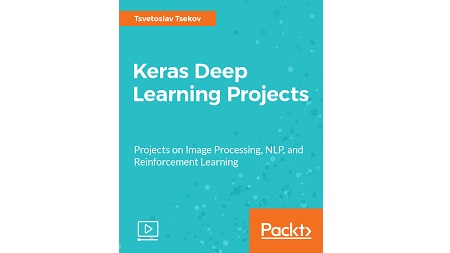
English | MP4 | AVC 1920×1080 | AAC 44KHz 2ch | 2h 43m | 566 MB
Learn to build cutting-edge Deep Learning models in a simple, easy to understand way.
Keras is a deep learning library for fast, efficient training of deep learning models, and can also work with Tensorflow and Theano. Because it is lightweight and very easy to use, Keras has gained quite a lot of popularity in a very short time.
This course will show you how to leverage the power of Keras to build and train high performance, high accuracy deep learning models, by implementing practical projects in real-world domains.Spanning over three hours, this course will help you master even the most advanced concepts in deep learning and how to implement them with Keras. You will train CNNs, RNNs, LSTMs, Autoencoders and Generative Adversarial Networks using real-world training datasets.
These datasets will be from domains such as Image Processing and Computer Vision, Natural Language Processing, Reinforcement Learning and more.By the end of this highly practical course, you will be well-versed with deep learning and its implementation with Keras.
By the end of this course, you will have all the knowledge you need to train your own deep learning models to solve different kinds of problems.
The course aims to explains the Deep Learning concepts in a simple, easy to understand manner and provides intuitive knowledge of the subjects. After you have grasped the concepts of a model, you will learn how to implement it with Keras.
What You Will Learn
- Grasp the Concepts and intuitive understating of Deep Learning
- Build your own Multilayer Neural Networks
- Explore the Concepts of Convolutional Neural Networks and Recurrent Neural Networks
- Build Convolutional Neural Networks and Recurrent Neural Networks
- Use transfer learning to greatly increase CNN performance
- Use Concepts, intuitive understating and applications of Autoencoders and Generative Adversarial Networks
- Build Auto encoders and Generative Adversarial Networks
Table of Contents
01 The Course Overview
02 Jupyter Notebook Basics
03 Data Shapes
04 Neural Networks and How They Are Implemented with Keras
05 Building Connected Layers and Applying Activation Functions
06 Applying Loss Functions and Optimizers for Backpropagation
07 Advanced Implementation with Keras
08 Training the Model
09 Testing the Model
10 Metrics and Improving Performance
11 Concepts of CNNs
12 Applying Filters, Strides, Padding, and Pooling
13 Basic Implementation with Keras
14 Leaky Rectified Linear Units
15 Dropout
16 Advanced Implementation with Keras
17 Training the Model
18 Testing the Model and Metrics
19 Transfer Learning
20 Concepts and Applications of Autoencoders
21 Basic Implementation with Keras
22 Advanced Implementation with Keras
23 Convolutional Autoencoder with Keras
24 Training the Model
25 Testing the Model
26 Concepts of RNNs, LSTM Cells, and GRU Cells
27 Data Preprocessing
28 Building a Simple RNN Model in Keras
29 Advanced Implementation with Keras
30 Training the Model
31 Testing the Model
32 Concepts and Applications of GANs
33 Batch Normalization
34 Convolutional GAN with Keras
35 Training the Model
36 Testing the Model
Resolve the captcha to access the links!